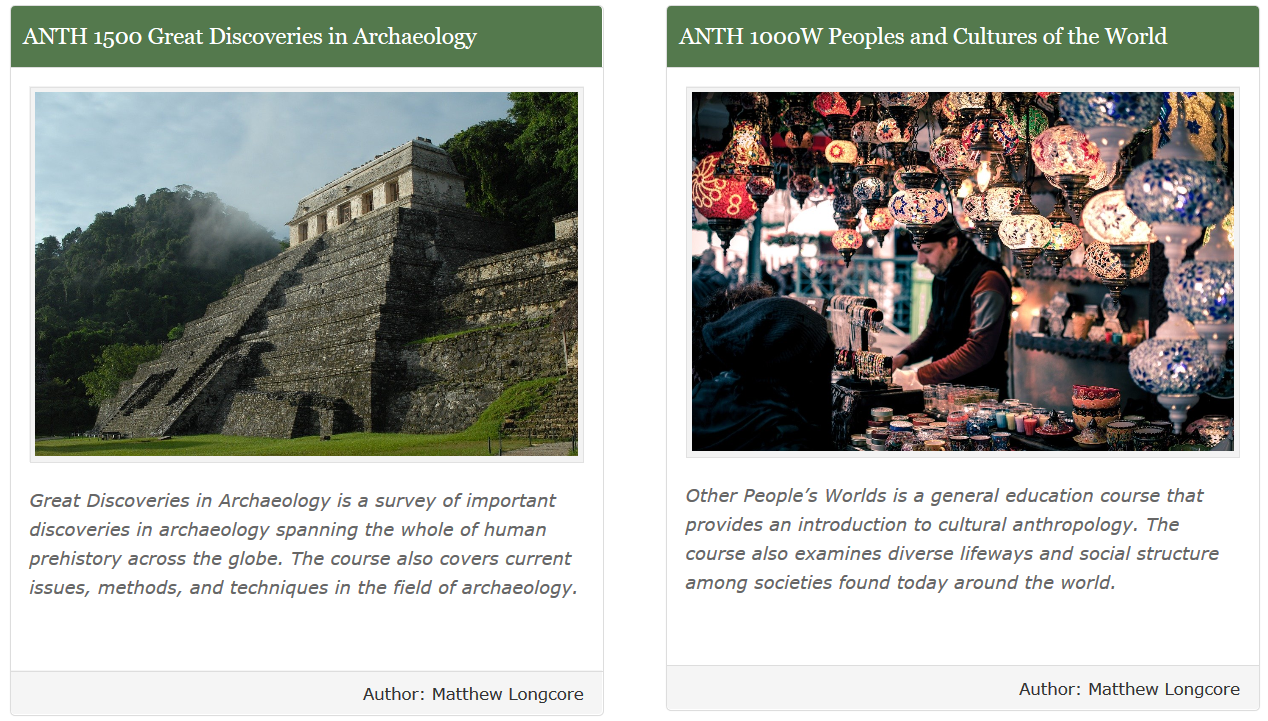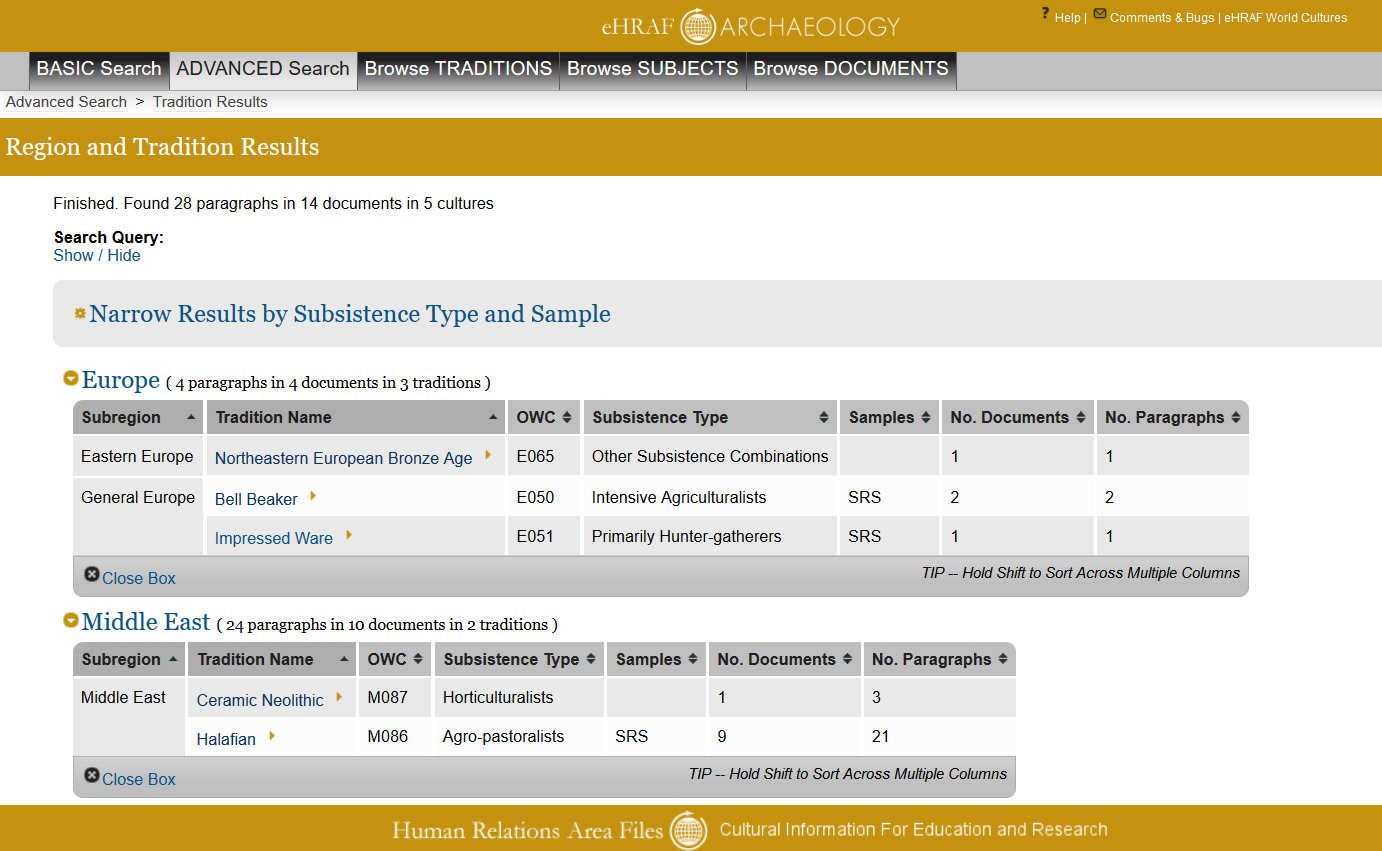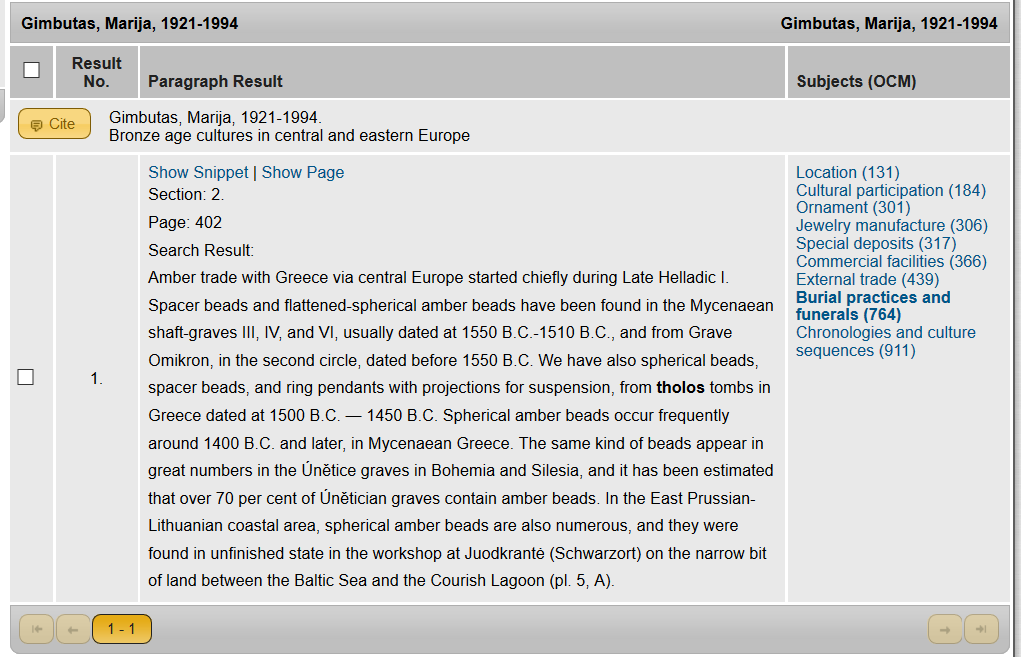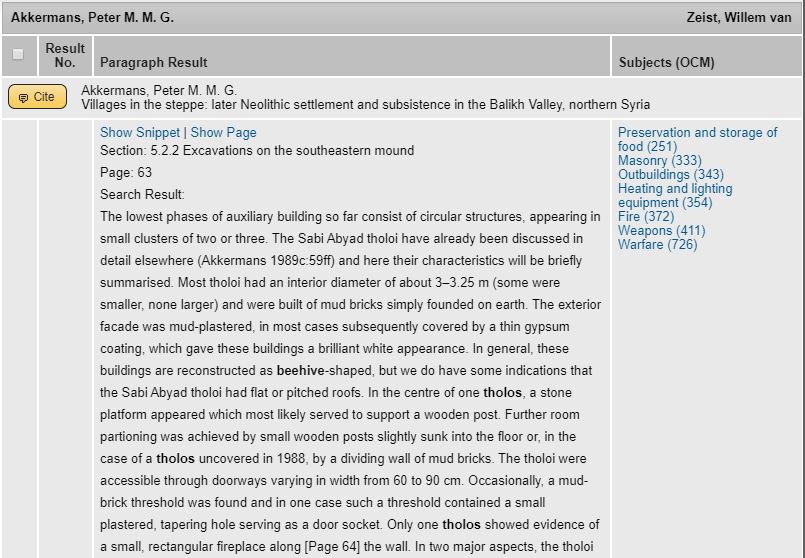
“I must admit that through my college career so far, this was the most enjoyable topic to research! Thank you for the opportunity and teaching us how to use eHRAF. I will be using this database for many more papers to come!”
Christina Hardacre, UConn Senior, History major
“This was the first time I had taken an anthropology class and I truly enjoyed it! I enjoyed everything from the presentations to writing the research paper and learning about eHRAF!”
Rashana Weerasinghe, UConn Freshman, Business Data Analytics major
As the academic year comes to a close, HRAF is pleased to have received positive feedback from faculty and students who have engaged in courses that have included the eHRAF databases and open access resources in the curriculum. At the beginning of the Spring 2020 semester, we shared new anthropology and archaeology teaching assignments from Matthew Longcore, our member services manager who also teaches anthropology and archaeology courses at the University of Connecticut. This semester, Matthew incorporated eHRAF into two UConn courses, ANTH 1000W Peoples and Cultures of the World (formerly Other People’s Worlds) and ANTH 1500 Great Discoveries in Archaeology. The syllabi and eHRAF assignments for each course are available to view and download in Teaching eHRAF.
Having a HRAF anthropologist teach introductory courses at a member institution provides us with valuable insight into teaching and learning with eHRAF. We are especially fortunate that this semester the two UConn courses featured both of our flagship research databases, eHRAF World Cultures and eHRAF Archaeology, as well as information from Explaining Human Culture (EHC) and Introducing Cross-Cultural Research.
In this post, Professor Longcore offers reflections from each of his courses, as well as recommendations for other faculty members who may be planning to teach with eHRAF.

ANTH 1000W Peoples and Cultures of the World
ANTH 1000W Peoples and Cultures of the World is an introductory writing-intensive course in cultural anthropology. Cross-cultural comparisons help students understand the differences and similarities among extant societies, as well as providing a perspective for evaluating one’s own society and place within it. The course is considered a first year, or freshman level, course with college-level English as a prerequisite. Here is the course description:
An introduction to the anthropological understanding of human society through ethnographic case studies of selected peoples and cultures, exploring the richness and variety of human life. Encourages students to learn about different cultures and to apply their knowledge to make sense of their own society.
To meet the writing requirement for the course, students are expected to submit a research paper using eHRAF. The paper should address a specific cultural behavior or topic of their choice (e.g. romantic kissing) and a related research question (e.g. is romantic kissing a cultural universal?). Students use data from eHRAF World Cultures to answer the question and must select any three cultures to research their topic. The assignment provides students with sample topics, tips for selecting a research question, the step-by-step process for the development of the research paper, and guidelines for writing the paper. The completed assignment should comprise a minimum of 9 pages, double-spaced, including a title page, and references cited.
The assigned textbook for ANTH 1000W is Cultural Anthropology: An Applied Perspective by Ferraro and Andreatta. This textbook is ideal for preparing students to explore eHRAF as it has several references to the Human Relations Area Files, George Peter Murdock, and cultural universals. To help students get started with selecting a topic, Professor Longcore presented the concept of cultural universals and reviewed a list from Murdock with the class. Longcore explained to his students that cultural universals are those general human traits found in all societies of the world. By examining the cultures of the world in a comparative way, anthropologists can begin to discover similarities and differences between cultures and can identify common denominators.
Based on feedback received early in the course, students appreciated having the opportunity to select a topic for their research based on their own interests, or to develop a new theme on a facet of culture that they discovered independently while searching in eHRAF. For example, a senior double majoring in Financial Management and Economics was actively engaging in internship opportunities to prepare for graduation and wanted to examine the question of “Are Apprenticeships A Cultural Universal?” The research topics developed by students represented the diversity of their interests as well as the broad scope of ethnographic data available in eHRAF. Here an example of a successfully completed research paper. Highlights from all of the student research papers are showcased in the following slideshow:
Professor Longcore invited his colleague Dr. Francine Barone to present a one-hour webinar on how to effectively use eHRAF World Cultures for the research paper assignment. In the webinar, search strategies were covered by introducing articles written by Dr. Barone on the HRAF homepage. These articles served as a model for students to compose their own research papers using ethnographic evidence from eHRAF. During the webinar, students were able to ask questions about how to navigate the databases in order to find relevant information to complete their assignments. Of particular interest were recommendations for saving information and citing sources. Students described the personalized experience of the webinar as extremely helpful and were especially thankful to Dr. Barone.
HRAF highly recommends that faculty who are teaching with eHRAF schedule a webinar for their classes. For those instructors assigning an eHRAF research paper, it is also particularly helpful to share posts from the HRAF homepage with your students as they are accessible examples of research featuring popular anthropological topics which appeal to students. Additionally, all of the ethnographic and archaeological sources included in the posts have been properly cited with links to the databases.
At the conclusion of the course, Professor Longcore created a presentation which features the work of each of the students including their research topics and direct quotes from their papers. Students were glad to have the opportunity to share their research topics with their classmates and to discuss the process of developing their papers. The students thoroughly enjoyed the journey of cultural discovery that they had undergone in order to produce their papers, and were amazed that they were able to find such diversity of ethnographic information in one place.
ANTH 1500 Great Discoveries in Archaeology
ANTH 1500 Great Discoveries in Archaeology is an introductory course in archaeology which is considered a first year, or freshman level, course with no prerequisites. Here is the course description:
Survey of important discoveries in archaeology spanning the whole of human prehistory across the globe. Current issues, methods, and techniques in the field of archaeology.
The required textbook for the course is Archaeology: Down to Earth by Kelly and Thomas. In this course, students are required to make team presentations on archaeological topics inspired by stories featured in articles from National Public Radio (NPR). Presentations should be about 30-45 minutes in length, followed by adequate time for class discussion of the topic. The format for the team presentations can be found here. Here is a slideshow containing highlights from all of the student team presentations this past semester:
Research using eHRAF Archaeology is a required part of the team presentations. Here is one of stories from NPR that was the focus of a team presentation and an excerpt from the article which helped the team get started with their research:
Archaeologists Discover Ancient Greek Royal Tombs Dating Back 3,500 Years
The findings cast a new light on the role of the ancient city — mentioned in Homer’s Odyssey — in Mediterranean trade patterns of the Late Bronze Age. Each of the two tombs — one about 39 feet in diameter and the other about 28 feet — was built in a dome-shaped structure known as a tholos.
To expand on the topic as presented in the article, the team was able to find relevant information in eHRAF Archaeology using the following search terms:
SUBJECT: Burial practices and funerals (764)
KEYWORD: tholos

Students were encouraged to take a comparative approach to their presentation topics. The search described above of the keyword “tholos” along with the subject Burial practices and funerals (764) returns results in both Europe (3 traditions) and the Middle East (2 traditions).
As shown in the search result below, eHRAF Archaeology has information about tholos tombs in Greece during the Bronze Age which is related to the topic of the NPR article. Students were able to synthesize these findings with other discoveries about the archaeological record concerning burial practices in ancient Greece.
The NPR article mentions another burial site known as the Griffin Warrior grave which “yielded significant findings including gold and silver treasure, jewelry and a long bronze sword believed to have possibly belonged to one of the early kings of Pylos.” Similarly, the eHRAF result below mentions amber beads found in the tholos tombs of Greece as well as in the East Prussian-Lithuanian coastal area and also along the Baltic Sea.

Further research into tholoi (plural of tholos) reveals that they were beehive-shaped structures used for burial in several cultures in the Mediterranean and West Asia. In other cultures, these structures were used for alternative purposes such as rituals, dwellings, and fortification. Here is an example from a Later Neolithic settlement in Northern Syria described in eHRAF Archaeology:

One of the student teams was especially enthusiastic about having the opportunity to research a topic related to local history in Connecticut:
Archaeologists Discover Evidence Of Connecticut’s Earliest English Colony
On the grounds of Wethersfield’s Webb-Deane-Stevens Museum, archaeologists have discovered evidence of the oldest English colony in Connecticut. In 2016, the Webb-Deane-Stevens Museum decided to add a new education and visitor center on the premises. To ensure the addition would not disturb any historically significant artifacts on the site, they hired the Public Archaeology Survey Team to conduct an archaeological survey.
As shown in their team presentation, the students discovered that the director of the Stamford Historical Society, Dr. Thomas Zoubek, has a PhD in Anthropology from Yale University where he specialized in archaeological studies. The students were excited to learn that great discoveries in archaeology are not only to be found in far off distant lands, but can also be studied in their own backyards. The UConn Stamford Anthropology Society is looking forward to taking field trips to local historical societies to learn about about the archaeological record of New England.

Teaching with eHRAF
Reflecting on his experience teaching with the eHRAF databases, Professor Longcore shared the following:
I found that eHRAF is ideally suited to teaching introductory courses in cultural anthropology and archaeology. My main objective is to get students to think comparatively and cross-culturally. Students are encouraged to take an aerial view of the world – past and present – and to see the interconnectedness of cultures and traditions in terms of similarities and differences. With the click of a button, students are able to make startling discoveries through a repository of trusted resources.
Students from both courses were excited to learn about anthropology and found the subject to be engaging well beyond their expectations. While many of the students enrolled in the courses simply for the purpose of satisfying distribution requirements, they emerged with a deep passion for anthropology, seeing its relevance to their own lives and career aspirations. Some students even expressed interest in taking more advanced courses in anthropology and possibly adding a minor or major in the subject. The UConn Stamford Anthropology Society, which is advised by Professor Longcore, also saw an increase in membership as the result of the two courses. Some of the students enrolled in the courses were participants in HRAF’s celebration for Anthropology Day 2020 which featured presentations from HRAF staff members, famous New Haven pizza, and a tour of the Yale Peabody Museum.
We are pleased that the eHRAF databases have played such a significant role in attracting a new generation of anthropologists with the help of dedicated instructors like Professor Longcore.
Contribute & Collaborate
Teaching eHRAF is made possible with the help and generosity of educators who use eHRAF in their classrooms. Instructors are invited to contact HRAF with innovative and practical teaching ideas. We encourage educators to collaborate with us and to share any eHRAF-themed teaching materials that they have produced. If you would like to contribute to Teaching eHRAF, please contact Dr. Francine Barone at francine.barone@yale.edu.